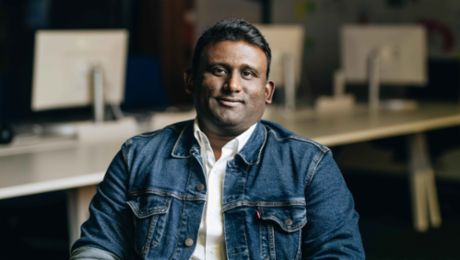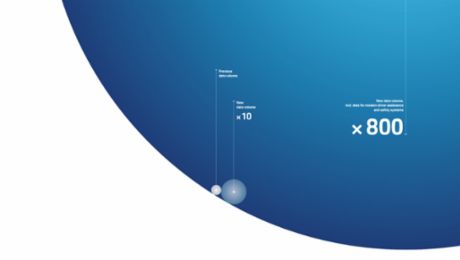Hardware and software, steel and electronics, tradition and future—elements that complement one another and ideally form a single unit. Michael Steiner and Sajjad Khan are two members of the Porsche AG Executive Board in charge of two departments with a shared vision. “It’s ultimately all about creating a harmonious product,” says Steiner. “Vehicles with that unmistakable Porsche DNA inspiring our customers time and time again.” Khan adds: “Our traditional virtues and abilities form the core of our brand. But we’re also expanding these to include innovations from the digital world.”
Connectivity and infotainment
That’s precisely why Sajjad Khan was appointed to the Board in November 2023. As head of the newly created Car-IT department, he’s primarily responsible for connectivity and infotainment. His team also focuses on integrating the ecosystems of third parties and developing digital vehicle solutions such as the My Porsche app. “Software is changing every aspect of our lives,” Khan explains. “Even household appliances are now an everyday element of the Internet of Things. More and more, the car itself is actually a component in a larger network.” It’s a component, however, with a highly emotional, practical value. “The driving experience takes center stage at Porsche.” That’s something Khan himself experiences on a daily basis, as his company car is a 911 Turbo S.
Michael Steiner, who has been with the company since 2002, took charge of the Research and Development department in 2016 and has not only left his mark on new model lines such as the Panamera, Macan, and 718, but also launched full Porsche electrification in the form of the Taycan. “Just like everywhere else in the industry, we’re experiencing a huge transition at Porsche,” he says. “And it’s not just the dominating issue of electric mobility, but also new software-based functions associated with the fast-growing potential of connectivity. That has an impact on the car’s traditional ecosystem.”
Connectivity and integration are key words and play an essential role in the development of future sports cars—and in the collaboration between the two departments—which is why the two Board members share an office space at the Weissach Development Center.
Because hardware and software are inextricably linked in vehicle development, Steiner will also be responsible for developing driver assistance and autonomous driving functions in the future. The same could be said for the electric and electronic architecture and infrastructure for the vehicle as a whole. “There’s not a single unit in my department that doesn’t achieve its results in close collaboration with Sajjad’s units,” says Steiner. “It goes both ways,” emphasizes Khan. “The power of innovation will unlock enormous potential as long as we develop ideas together in our teams.”
The experiences that customers have in other environments, they also want to have in their cars. Michael Steiner, Member of the Executive Board responsible for Research and Development
Designing the sports car of the future together also means fulfilling ever-growing demands such as new drive technologies, new regulations, and regional requirements. It’s also about fulfilling customer expectations in terms of performance, safety, comfort, connectivity, and infotainment. Examples include route recommendations provided by the navigation system with real-time information as well as the intelligent charging planner for all-electric Porsche sports cars. Or the option to play your favorite tunes on the car speakers directly from your smartphone. This vehicle interaction trend is just going to grow and grow. Nowadays it’s also necessary to provide updates and new functions even after a car has been purchased. Steiner views the personal companion that is the smartphone as a role model in this area. “The experiences that customers have in other environments, they also want to have in their cars.”
“Expectations are growing with the technical possibilities,” says Khan. “Anyone who has smart home functions in their house wants to be able to activate them on the way home, for example.” The same could be said for the wide variety of mobile entertainment options. The connected vehicle will increasingly be a communications center, but with pronounced regional differences. “Chinese customers use their own digital ecosystems and platforms for messages, chats, entertainment, and payment,” says Khan. “As a global brand we need to take that into account.” His department is taking the lead when it comes to R&D satellite in China, while other ecosystems could be interesting in other regions around the world. “That’s why different forms of collaboration would be possible in different markets,” explains the head of Car-IT. “We integrate partners’ digital ecosystems wherever it makes sense. At the same time, we also know exactly where we want to maintain superiority in systems and data. We work with major tech players, but also plan to implement our own solutions with expertise,” says Khan, describing a strategy of both collaboration and competition.
Signature feel of Porsche driving experience
After all, there are no compromises—especially when it comes to the driving experience. “A Porsche will need to drive like a Porsche in the future too,” explains Steiner. “That continues to be a central distinguishing feature. For example, our models are well known for their extraordinary braking and high-precision control.” Models with combustion engines are decelerated by converting the car’s kinetic energy at the brakes into heat through friction. In all-electric vehicles, on the other hand, the brakes are largely applied by means of recuperation—the electric motor converts the car’s kinetic energy into electrical energy, while maintaining the signature feel of Porsche braking. “That’s just one example of how we combine traditional and digital worlds,” explains Steiner.
We’re expanding our traditional virtues and abilities to include innovations from the digital world. Sajjad Khan, Member of the Executive Board responsible for Car-IT
“The traditional mechanical aspect and the software need to work together to maintain the impressive quality and innovation,” says Khan, adding that this not only refers to car technology and systems, but also the environment as a whole. “It also applies to the cloud and apps.” Cars have been evolving into high-performance computers on wheels for quite some time now. More and more control units enable new functions and thus new driving and comfort experiences. The growing amount of data also opens up many new opportunities for developers and is one of the driving forces behind innovation in the automotive industry.
Khan and Steiner predict that more and more functions of artificial intelligence will find their way into the car. Conversation with the vehicle in natural language is already a major topic in Asia and will soon be an expected standard in the other regions of the world. The two board members also believe that sensors will make it possible for an intelligent car to recognize drivers and passengers and respond to their needs. Intelligent assistance systems for partial automation (or more) are topics of discussion at Porsche. “There will eventually be a demand for anything that makes driving more comfortable and safer,” says Steiner with confidence. “Even if our sports cars are still built for driving fun.” He doesn’t view these as mutually exclusive. Even in the age of digitalization, he’s able to identify more than enough opportunities to distinguish Porsche. “We need to ensure we define a form of intelligent vehicles that will appeal to customers,” adds Khan. “But that will only work if we remain true to ourselves.”
Sajjad Khan and Michael Steiner both agree that tradition and progress are inextricably linked at Porsche, as are continuity and innovation.
Big Data
Vehicles are evolving into high-performance computers on wheels—one only need look at the amount of data that flows through them. Highly automated driving functions, in particular, will result in exploding data rates in the future. The use of data in development is likely to accelerate, as the growing quantities of data and new technology such as quantum computers will provide engineers with new prospects—and customers with unexpected driving experiences.
The content of this website presents selected information from the annual and sustainability report 2023 of Porsche AG. All information therefore relates to the reporting date and has not been updated since its publication on March 12, 2024. The German PDF document of the annual and sustainability report is legally binding.


